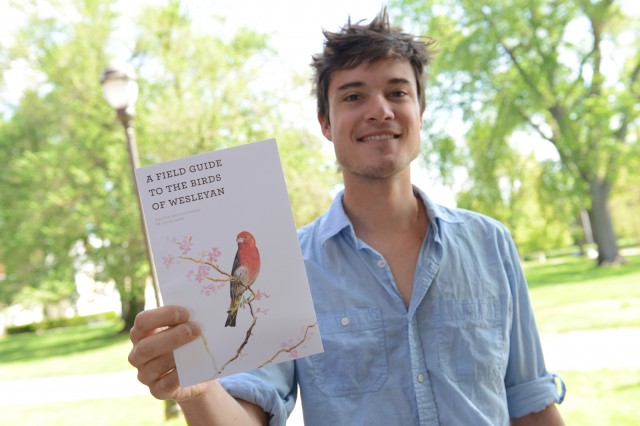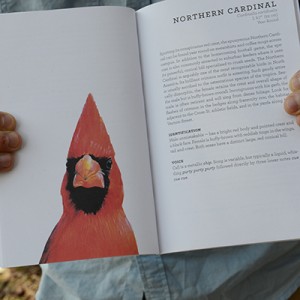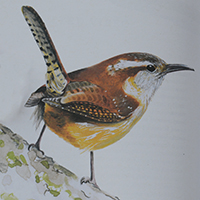James ’14 Publishes Field Guide to the Birds of Wesleyan


“Sporting its conspicuous red crest, the eponymous Northern Cardinal can be found year round on sweatshirts and coffee mugs across campus. In addition to the homecoming football game, the species is also commonly attracted to suburban feeders where it uses its powerful, conical bill specialized to crush seeds. The Northern Cardinal is arguably one of the most recognizable birds in North America.”

So begins an entry on the Northern Cardinal, or cardinalis caridnalis, in A Field Guide to the Birds of Wesleyan, a book written and illustrated by Oliver James ’14 for the capstone project of his College of the Environment major. The book, containing descriptions and illustrations of 16 of the most common birds found on Wesleyan’s campus, was published by Stethoscope Press, a student-run writing and publishing group, with a limited release of 300 copies.
James has been an avid birder since about the age of 5. One of his earliest memories growing up in Berkeley, Calif is of accompanying his aunt, a field ornithologist, to Bodega Bay, where she was researching the vocalizations of a type of sparrow.
When James arrived at Wesleyan, he naturally took note of the local birds, which were very different than those in his hometown.
“When you’ve been a birder for long enough, identification almost becomes subconscious,” he explained. “Pretty much wherever I go in the world, I’m attuned to what is passing through.”
In studying toward his biology-linked COE major, James felt there was a dearth of courses that were predominantly field based.
“Learning biology in the classroom and lab is obviously invaluable if you want to become a scientist. There’s more problem solving, theory and rote learning,” he said. “But what I think is missed is the applied science. So much biology, ecology and natural history can be learned simply by walking outside and just being a close observer of your native ecosystem.”

He sought to fill this gap by co-leading a student forum in spring 2013 titled, “An Introduction to Field Ornithology and the Birds of Central Connecticut.” The class was met with enormous interest. Though the leaders were required to cap enrollment at about 15 students, other students would show up for weekend trips to the field to practice birding.
At the end of the course, James realized how valuable a printed field guide would have been for reference.
“It would have been really great for the students and the wider community, to inspire people to learn the birds themselves,” he said. “I decided it would be a great resource to leave with the Wesleyan community so that this kind of work and interest in natural history could continue beyond my years here.”
Each of the 16 entries in the book contains the bird’s common name, scientific name, measurements, time of year when present, and descriptions of primary vocalizations, essential field marks and behavior. James illustrates each in mixed media of watercolor, gouache and colored pencil. The book’s introduction explains, “Each bird is depicted in a way that attempts to capture the beauty and physicality unique to each species while also highlighting the key field marks needed for ready and accurate identification.”
In addition to his studies in the sciences, James tried to take as many art studio courses over four years as he could fit in. He thanks Assistant Professor of Art Julia Randall for serving as his unofficial advisor for the book’s illustrations, and credits Professor of Art Tula Telfair and Visiting Assistant Professor of Art Laura Grey, whose classes were influential in James’ paintings and design of the book.
Working with Stethoscope Press, James was paired with a student editor, with whom he worked for one academic year on writing the book. The press then distributed 300 printed copies of the book to the student body free of charge. According to James, the copies were claimed very quickly.
“I left feeling very gratified and like my mission was accomplished. I’ve had students, faculty and administrators write me emails, and come up to me to give feedback about why they think the project is valuable,” he said. “My personal goal in publishing the book was fulfilled in that it was meant to inspire people to at the very least keep their eyes up to the sky while they’re walking across campus making their daily circuit.”
James recently has been talking to Wesleyan University Press about possibly printing another round of the book in the future.
Next fall, James will head to the Farallon Islands, a very small, rocky set of islands in the Pacific Ocean about 30 miles west of San Francisco, to work with an organization called Point Blue Conservation Science. He will be monitoring land birds that are migrating down the coast of California.

